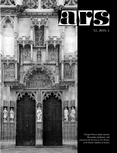
Journal ARS 52 (2019) 1
Jakub Adamski
On the Stylistic Sources and Dating of the Portals in the Augustinian Church of Saint Catherine in Cracow- Kazimierz and their Relationship with Portals in the Parish Church of Saint Elisabeth at Košice
(Summary)
Close formal affinities between the decorative portals in the south aisle and porch of Saint Catherine’s church of the Hermits of Saint Augustine in Cracow-Kazimierz and the three nave portals of the parish church (now cathedral) in the city of Košice (now in Slovakia, in the medieval period – in Upper Hungary) were discovered by August Essenwein as early as over 150 years ago. Undoubtedly, the above works are the most original and simply the most important portals from the end of the fourteenth and the beginning of the fifteenth century in this part of East Central Europe. The enormous extent of their artistic influence is best attested by the fact that they started two independent regional group of portals: with stepped heads in Lesser Poland and with fanciful ornamented crowns in Hungary (especially in Transylvania). Since Essenwein’s times, the problem of the relationship between the portals in Cracow and Košice has intrigued many generations of, especially Polish, Slovak, Czech, Hungarian and British, art historians. The present paper is an attempt to provide a definitive answer to the questions about the relative and absolute chronology of the portals under discussion and their artistic relationship. A prerequisite for this task is to present new observations on the architecture of the south aisle and porch of the Kazimierz Augustinian church, which have been less thoroughly researched than the huge Košice parish church. Thanks to these new observations and an analysis of written documentary materials, it can be unequivocally stated that it is the Cracow portals that are slightly older, and they must have been among the most important sources of inspiration for the architect who had continued the construction of the Košice parish church since the beginning of the fifteenth century. The chronological precedence of the portals in Kazimierz is based primarily on an observation that the southern part of the church must have been completed in the very first years of the fifteenth century at the latest, when the chapel of Stibor from Ściborzyce, adjacent to it from the west, was erected. The porch along with its portals had been very likely completed about a decade earlier, that is, long before the works on analogous elements in the Košice parisch church were started. The final part of the paper indicates stylistic sources of the highly unusual composition of the Kazimierz portals, which combine the then most recent Parlerian motifs with inspirations derived from older, but very fanciful, portals that had appeared in the architecture of Austria, Bohemia and Silesia from the thirteenth century. It was very likely these features that contributed to the uniqueness of a design that later inspired the master who built the Košice parish church.